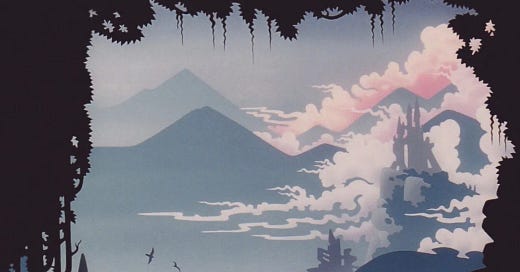Review | “Valley of the Birds” by Emerald Web
Rediscovering two pioneers of bliss-out analog synthtronica
Based in the San Francisco Bay Area, the mysterious Emerald Web duo, comprised of Kat Epple and her husband Bob Stohl, was active between 1977-'90, releasing twelve albums in total, most of them originally on cassette and unavailable today, or at least very hard to track down online. “Valley of the Birds” (Remastered), originally released in 1981, is the authorized version of the fourth album.
For the 2020 re-appearance of this magical record, the original reel-to-reel master tapes were baked for “sticky shed syndrome,” transferred to digital and remastered for this official remastered album release.
In general, the music of Emerald Web broadly falls under the neo-classical or minimalist umbrella but also incorporates many elements of the new-age, ambient, and electronic genres.
Orchestration is usually centered by an array of analog synths which were “state of the art” back then and are now vintage, including Lyricon 1 Electronic Wind Instrument, Arp 2600, Moog, sequencers, along with vocals, classical, acoustic, and traditional world music instruments.
Specifically in “Valley of the Birds”, the flute predominates, in many permutations: its breathy sound is transformed from a straightforward wind instrument to various interpretations thereof, proving to be a versatile vehicle for elaborate electronic treatments, exotic effects, and radical recording studio techniques.
Always following the trails of delicate harmonies along pleasant melodic paths, a jazzy improvisational flavor is never far from the surface, but neither do the restrained compositions stray far from a considered, measured, and decidedly symphonic context.
“Valley of the Birds” is the perfect representation of a lost form of perfection – an ambitious experiment of fearless conviction, the work of artists bravely positing themselves outside the norm of popular consensus, daring to imagine sounds that only started to mature decades later, even if their futuristic undertones and East Coast psychedelic philosophy were already a very prominent style for their contemporaries such as the bands collectively belonging to the Berlin School of Electronics, Mike Oldfield, Vangelis, Tangerine Dream and of course the seminal Kraftwerk.
A careful listener might want to explore Emerald Web further and indeed there is much more of their material to be excavated and appreciated under the new lens of 21st-century century electronica when labels like Clay Pipe Music and Ghost Box are fixating on the retro-futuristic fixations rooted in an alternative narrative of our musical past, one ignored by mainstream pop yet obviously very rich in unexplored gems.
According to the sleeve notes,
"Dragon Wings and Wizard Tales” was their first of 12 albums: “ Whispered Visions", "Sound Trek", "Valley of the Birds", "Aqua Regia", "Nocturne" (another Psyel favorite), "Lights of the Ivory Plains", "Traces of Time", "Catspaw", "Dreamspun", and "Manatee Dreams of Neptune". ...in addition to recording the albums in their studio, Emerald Web also composed film scores for PBS, Apple Computers, documentary soundtracks for famed astronomer Carl Sagan, and others.
They were renowned for their live performances which took place in alternative venues such as Planetariums, Astronomical Observatories, science museums, caverns, the Redwood Forest, the Academy of Sciences, The Oakland Zoo, and Science Fiction conventions.
There were not a lot of Electronic Music bands playing live in concert because of the difficulty and complexity of performing on these early analog synthesizers and sequencers which had volatile memory, drifting intonation, and no pre-programmed sound banks.
Emerald Web’s concerts also incorporated visual elements, including contemporary dance, live artist painting, lasers, liquid projection, computer animation, photography, and analog video feedback projected on fabric screens
Their concerts in planetariums, observatories, museums, and other unusual venues, were performed on an array of now-vintage synthesizers, Lyricon Electronic Wind Instruments, flutes, and other acoustic instruments.
Although Emerald Web had a significant influence on music at the time, there is little documentation about this mysterious band and their important hybrid music from a transformative music era...”
That final phrase seems to seal the deal: sparsely documented, sublime to listen to, eccentric in the most Arcadian, lyrical, Utopian, and Uchronic way possible, Emerald Web has found its permanent place as a special case in the Science of Exceptions.
Text written by Panagiotis Chatzistefanou, Berlin January 2024




